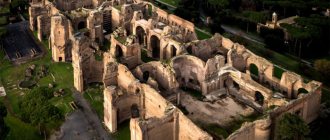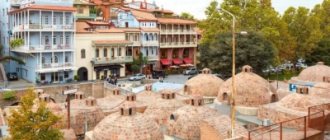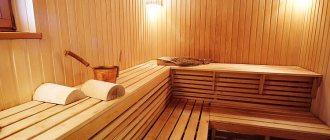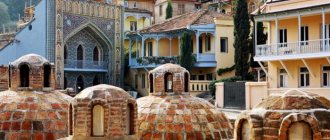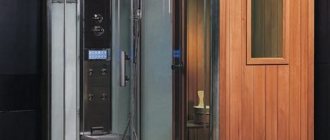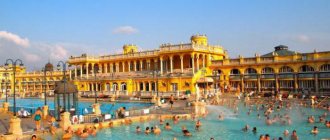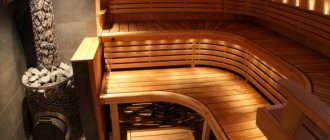Of all the ancient bath structures known to history, Roman baths are rightfully considered the most advanced in terms of process technology and service organization. When it comes to visiting the sauna, directly organizing procedures and relaxing in ancient baths, the Roman builders and keepers of bathhouses were the best. Even in a modern sauna or a simple Russian bathhouse, built according to all the requirements of construction science, it is not always possible to achieve the level of comfort and relaxation that was available in Roman baths for citizens of Ancient Rome.
Roman Baths is a whole health complex with baths and healing waters
What are therms
In terms of their structure, public baths in Ancient Rome consisted of several buildings combined into one complex, which had a huge main hall and up to a dozen smaller rooms, which, in fact, housed the ancient Roman baths, with steam rooms, saunas, swimming pools and treatment rooms . In a broad sense, baths in the Roman Empire were also a place where you could wash and clean yourself up, receive medical treatment and communicate with citizens. But this is not the main thing; in modern thermal baths you can often find a similar level of service, medical support for visiting the sauna.
The sauna replaced the club and served as a place for citizens to communicate
The main difference between Roman baths and modern saunas and steam rooms is in organizing the process of visiting the bath:
- The complex included rooms with different temperature conditions, there were wet hot steam rooms and relatively dry saunas, oriental “cool” baths and Arabic rooms with incense, several pools with water of different temperatures;
- The largest ancient Roman baths were heated by wood-burning stoves through the floor. There was no trace of combustion products inside the room, regardless of the weather and wind direction outside;
- A special heating mode, and public Roman baths were heated almost around the clock, maintained the most comfortable conditions inside the baths.
Each visitor had the opportunity to choose his own heating mode, moving from colder oriental hammams to a hot sauna. There was simultaneously access to several pools with different water temperatures. As a result of this organization of work in Roman baths, visitors, even with a minimal level of medicine, practically did not suffer from overheating, heat or contrast shocks.
Important! Particular attention was paid to ventilation. Roman baths were heated and ventilated by ducts built into the walls. Therefore, regardless of the weather and air temperature outside the bathhouse, the air inside the room was fresh and warm.
The main city baths were not inferior in size to palaces
The water in the pools and baths was changed at least once every three days. In terms of sanitation, the baths in Ancient Rome were an order of magnitude better compared to Turkish, Arab or ancient Jewish baths.
The reason for the incredible popularity of the Roman bath lies in three simple points:
- Roman builders and architects are rightfully considered brilliant in matters related to architecture and planning of buildings, not only for baths or saunas. Ancient Roman baths have been copied for several thousand years and are recognized as the best;
- The baths in Rome were serviced by hundreds or even thousands of slaves and hired workers. Maintaining huge structures clean and tidy was possible only through slave labor;
- Huge amounts of money were spent on the construction and maintenance of bath complexes, materials that were best suited for constructing steam rooms and swimming pools were used.
In modern conditions, Roman baths would go bankrupt within a week after they were put into operation, but the layout of the premises, their structure and the organization of the process of visiting the sauna in Ancient Rome is still considered unsurpassed.
History of Roman Baths
The first bath complexes in Ancient Rome were built during the reign of Octavian Augustus. They were built at his own expense by a high-ranking official, Marcus Vipsanius Agrippa, a man far from the problems of Roman citizens, but undoubtedly smart and far-sighted. It was necessary to solve the main problem of the Roman troops and the population of the cities. Ancient Rome was periodically subject to epidemics of infectious diseases, especially the plague. Therefore, the construction of Roman baths became one of the ways to defeat the carrier of the disease, and after two to three hundred years, visiting the bathhouse became an element of ancient Roman culture.
Restored diagram of Diocletian's Baths
It is believed that the idea of Roman baths was borrowed from cattle breeders. In a country where there are plenty of volcanoes and mud thermal springs, the appearance of a bathhouse and the use of natural hot water for one’s own needs, processing and treating livestock was an inevitable phenomenon.
The largest Roman baths were built under Emperor Diocletian; the total area of the baths reached 13 hectares, and were designed for simultaneous visits of three thousand people. In fact, it was a whole palace made of marble and granite, with mosaics and sculptures. The elite of the Roman capital gathered and spent time in the Roman baths of Diocletian, therefore, in addition to the bathhouse premises, an amphitheater, sports and healing halls, a library and snack bars were built.
Important! The quality of the construction can be assessed at least by the fact that the water supply system installed in the Roman baths of Diocletian functioned properly without any mechanics for four centuries.
In fact, the baths themselves fell into disrepair after the partial collapse of the aqueduct and gutter system. The Roman baths were barbarically plundered and dismantled in the Middle Ages, in the middle of the 16th century.
Baths of Ancient Rome today
Part of the complex built by Diocletian has been preserved in the form of foundations and walls. The remains of the main building of the ancient Roman baths were used to strengthen the structure of Santa Maria del Angeli.
The rest of the buildings of the ancient Roman baths were less fortunate. Most of it was rebuilt according to modern designs, without preserving the unique walls and stoves. From some, as in the case of the largest Roman baths in history, Caracala, ruins remain in which the layout and structure of the complex can be traced. But even in this state, the Roman baths make modern experts marvel at the accuracy and thoughtfulness of the structure’s layout.
Phytosaunas
Today, phytosaunas have become quite widespread. Among their features, we note the following points:
- This design combines the effects of steam and saturated medicinal herbs.
- The structure is made of Siberian cedar; the substances released from this wood have a beneficial effect.
- Quite often, a steam line is connected to the structure, through which a healing herbal infusion is supplied.
- The steam temperature is maintained in the range from 25 to 55 degrees Celsius. Due to this, the procedure can be carried out over a long period, which determines the long-term beneficial effects of steam.
- Steam circulates freely throughout the system, thereby significantly increasing the efficiency of this procedure. To do this, the design has a compressor that creates pressure to circulate steam in the system.
- Wood cedar produces phytoncides that can fight various microorganisms. That is why the procedure has an antiseptic effect.
The design of most phytosaunas allows the use of both dry decoction and various balms. Due to this, the degree of beneficial effects of the procedure can increase.
In conclusion, we note that there are indications and contraindications for prescribing the bath procedure. Among the indications we note:
- Diseases of the upper tract.
- Problems with the musculoskeletal system.
- Exudative diathesis.
- Injuries of the lower extremities.
- Primary signs of hypertension.
However, there are quite a few serious contraindications:
- Epilepsy.
- Various infectious diseases that affect the skin.
- Various tumors.
- Bleeding.
- Blood problems.
In addition, a bath should be prescribed with caution for children or pregnant women. Heart problems are also quite often the reason why taking a bath leads to even greater problems.
There are quite a few different recommendations on how bath procedures should be carried out. So, many experts recommend gradually increasing the temperature, as well as the duration of stay in the steam room. Also, you should not jump into the pool immediately after the steam room, as a sharp temperature change has a serious effect on the body. If there are chronic health problems, air parameters should be selected individually.
Modern Roman baths
Ancient Roman baths are often copied for large bath complexes. A Roman bathhouse in a truncated form can be found in Sanduny, at the famous resorts of Gellert or Gedyk Pasha.
Modern baths differ from the baths built under Diocletian in almost all respects:
- Due to energy saving, the dimensions of the complex do not exceed the dimensions of a standard bathhouse. The finishing uses only imitation marble and granite, and heating is provided by electricity controlled by a computer;
- The number of rooms, as a rule, is limited to two or three; there is a sauna and steam room with a cooler temperature;
- In modern Roman baths there are practically no medical procedures or medical practices.
In fact, a modern Roman bath is a classic steam room with a sauna, decorated in the style of the luxury of Roman emperors. To attract visitors, thermal baths are built next to thermal or medicinal water sources.
1Thermal Baths of Agrippa
These were the first so-called “great baths”, whose appearance dates back to the 1st century AD. They appeared near the Pantheon in Rome. Their name was received in honor of Marcus Agrippa, their founder. This complex has undergone a lot of changes over the history of its existence, and some of it was even destroyed. To this day, all that remains of it are ruins.
You can see them when you get to the narrow street Via dell'Arco della Ciambella. Here they are practically squeezed due to the dense development of Rome with more modern buildings.
Design and mechanism of operation
The Roman bath, built according to the classical design, has three types of rooms for bath procedures. Firstly, this is a tepidarium, in which the air is heated to 40°C with low humidity. Visitors enter here from a separate locker room and undergo acclimatization.
Heating system for sauna rooms
Secondly, it is a slightly hotter caldarium, at 50°C and 100% humidity. In fact, this is an analogue of the Turkish hammam. Next comes laconium at 80°C and 15% humidity, this is a real sauna.
There is also a room for relaxation and massage and an extension to the sauna - a frigidarium, which has at least two pools, with cold and warm water.
The original Roman baths were heated by a separate stove; hot air was blown through natural draft through channels in the walls, so inside the sauna or even tepidarium there was always clean air, without the smell of insulation or old water and condensation on the walls.
Greece has everything
The Roman bath rightfully considers the ancient Greek bath as its mother. It was the ancient Greeks who laid the foundations of the public bathhouse, which, in addition to purely hygienic purposes, also had educational, health-improving and sports functions, and in many other ways was an active center for full-fledged and eventful leisure time.
Important! It is important to note that the Greek baths - laconicums, in turn, were largely borrowed from the Egyptian bath tradition. According to very controversial data, the founder of Greek baths is considered to be Alexander the Great, who was inspired, along with his nobility, by visiting the Egyptian baths.
The Greek bathhouse - laconicum - was built in the shape of a hemisphere, which was heated by an open fire from a hearth heated with charcoal. This type of fuel guaranteed a low amount of soot in the outgoing flue gases, high calorie content and, as a result, rapid heating of the internal volume. The widespread use of natural stone and marble resulted in excellent thermal characteristics and, first of all, the heat capacity of the bathhouse. An indispensable attribute of such an establishment were small non-flowing pools with cool or heated water. The Romans, who did not disdain the use of the experience of Greek civilization, taking the laconicum as a basis, created their own bathhouse, having for many centuries foreseen the instruction of dear Leonid Ilyich: “We need it to be like this, only better.”
Pros and cons for the body
The classic Roman bath is free from the main defect of modern steam rooms and saunas. If attended correctly, there is no risk of heatstroke or overheating of the body. Therefore, bath procedures are very effective for neuralgia, muscle tightness, fatigue and physical exhaustion. The immune system is definitely strengthened and metabolism improves.
Important! Ancient Roman baths were widely used to restore the strength and tone of legionnaires. In addition to traditional steaming and sauna visits, soldiers were forced to stretch, dislocations were reduced, and injuries were shunted. In the ancient Roman army, special people were responsible for the process of treatment and rehabilitation, and wages depended on how many people were returned to duty.
Bath procedures are strictly prohibited for infectious diseases, oncology and vascular problems.
There are also negative aspects to visiting a Roman bath. By design, the thermal baths remain “cold” and are designed for warm climates. Therefore, in winter you can easily get a cold from a draft.
Benefit
There is an opinion that the Roman bath, due to its gentle conditions, is most suitable for women who cannot withstand the high temperature conditions of other baths. Of course, soft steam has an excellent effect, opening and cleansing pores and improving blood circulation. But the advantages of the Roman bath can be felt by everyone who visits it.
It brings undeniable benefits:
The cardiovascular system is strengthened. This is a great way to prevent heart disease.
Mental state improves, depression goes away and sleep normalizes.
The skin is cleansed, impurities and toxins are removed, regeneration improves.
The functioning of the respiratory system improves.
Overloaded muscles relax.
Fatigue is relieved.
Immunity is strengthened.
But it should be remembered that the Roman bath is contraindicated:
- pregnant women;
- those suffering from colds or viral diseases, especially in the acute stage;
- in the presence of epilepsy;
- cancer patients;
- in the presence of inflammation, especially in the acute stage, if a chronic disease is in remission, you should consult a doctor;
- in the presence of cardiovascular diseases.
Roman sauna: visiting rules
In general, it took from one and a half to two hours to take a steam bath in the ancient Roman baths. In Ancient Rome, it was believed that visiting the bathhouse should occur after completing business and always before lunch. Therefore, the second half of the day was reserved for the nobility, and the morning and late evening for the common people.
Having left his clothes in the locker room, the visitor headed to the apodyteria. This is a place to sit, chat with friends, and psychologically adapt to stress. Regulars of the bathhouse often immediately went straight to the tepidarium, this is a room with a warm and fresh atmosphere; they spend at least 10-15 minutes in it until their breath gets used to the atmosphere of the bathhouse.
The next stage is the caldarium, where they wash with hot water, then move on to the frigidarium with a swimming pool. Often a visit to the Roman baths, especially in hot weather, ends with a conversation and relaxation by the water. For those who like to exercise, there is a choice of a sauna or a more moderate steam room. You can stay in each for no more than 10 minutes.
The procedure ends with a rest in the tepidarium. In the ancient Roman bath there was a special person who monitored the condition of visitors and, if necessary, could provide assistance.
Preserved Roman baths and saunas in Bath, UK
DIY Roman steam room
It is quite possible to build real ancient Roman baths, although the costs in terms of space and materials will exceed the estimate for a regular sauna at least twice. In fact, you will need to design two whole bathhouses under one roof with a swimming pool:
- To heat steam rooms, saunas and colder hammams, you will need to make two separate electrical circuits. Moreover, for a hot sauna, heaters are placed under facing ceramic tiles, both on the floor and on the walls of the room;
- In both steam rooms it will be necessary to make separate thermal insulation, ventilation and install an air heating control system;
- Between the sauna and hammam, a small isolated room for washing is traditionally left;
- The recreation room can be combined with a pool room.
When building Roman baths, you can use a water boiler with gas heating. It will be quite difficult to heat a sauna and at least one swimming pool using electricity alone.
